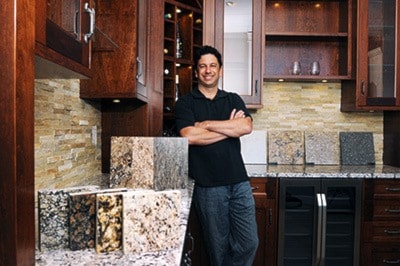Tired of looking at the same countertops every day? Perhaps you’ve considered replacing them with something more modern? More colourful? More upscale?
A countertop, whether in the kitchen or bath, is a great way to change the look of the room. A new countertop creates an instant focal point no matter your choice of material. And you’ll have plenty of choices should you decide to change the look and feel of your kitchen or bath with a new countertop.
Before you get started, however, here are a few helpful ideas about countertops from John Van Dregt, owner of All Style Cabinets, which has been supplying countertops and cabinets to Greater Vancouver homeowners for almost two decades.
Van Dregt says the starting point for any countertop change – after the initial decision is made to go ahead – is going to be personal taste and style. Though countertops come in a relatively small selection of types – granites, quartzes, laminates, butcher block, marble, tile, concrete, stainless steel and even a paper composite for example – there are literally thousands of colour and pattern options from which to choose, and all you have to do is find the one that suits you.
Van Dregt has offered some pros and cons for each of the materials, plus a price point that is reasonable for good quality materials and installation.
• Laminates: Van Dregt says laminates, the standard for decades, are still popular, primarily because there are so many options, and because it’s still the least expensive option. Each manufacturer has thousands of colour and pattern options, many of which mimic more expensive looks like granite or marble, and the quality is pretty consistent from one to the other, he adds. Another couple of pluses is that laminate is pretty easy to care for, and it installs quickly.
The downside of laminates is that they don’t take heat well, and can stain. They are also relatively easy to cut or scratch. Another problem is that wear and moisture can cause them to peel over time.
Price-wise, expect to pay about $30 a lineal foot for quality laminate and installation, although a flat lay with a different material for edging (probably wood) will cost a bit more.
• Quartzes: These are man-made products that combine resins with crushed rock to create fashionable, colourful countertops. Van Dregt notes they’ve been very popular because they come in a variety of styles that give one the look of natural stone, but they also create more uniformity of pattern, which many people like. They’re also considered maintenance-free and, in some cases, more durable than real stone.
The downside of quartzes, like all man-made substitutes for real stone, is the cost. Quartzes are pretty expensive – even more expensive than granite in some instances. You’ll probably pay $80 to $100 a square foot for a quartz finish countertop.
• Granites: Some people just love the idea, the look and the feel of natural stone and these folks will naturally gravitate towards granite countertops, says Van Dregt, and there’s no denying granite’s natural beauty.
The great thing about granite, he adds, is that your countertop will always be unique, and it comes in a wide variety of colours and vein patterns. The downside is that there will be some maintenance involved, although not nearly as much as some people think is required.
“There a misconception out there that granite stains easily, or that it’s a lot of work, but it’s not true. A once-a-year treatment with a sealer is about all it needs.”
Van Dregt says many people assume real stone will be more expensive than man-made, but he says granite can actually be about two-thirds the price if you’re prepared to look around for the best deals.
“There’s kind of a ‘natural’ versus ‘man-made’ debate out there, but, personally, I don’t think there are a lot of advantages or disadvantages to either. They both are excellent products if you buy quality and get them installed properly.”
• Marble: Not recommended by Van Dregt for kitchens because it truly does stain easily, and is too soft, so it chips more readily than, say, granite. He thinks it has its place in bathrooms, where there’s less likelihood that staining will occur. Another downside is that it’s also expensive.
• Butcher block: It’s definitely a nice look when done well, says Van Dregt, but it’s just as expensive as the other man-made products, and is probably the most difficult to maintain.
• Stainless steel: A good choice if you like a very modern, shiny look, but the fingerprints are going to drive you crazy, says Van Dregt with a chuckle. Stainless is expensive, but it’s nearly indestructible. The biggest problem will be avoiding dents; the clash of metal on metal; and you’ll want to watch what kind of chemicals you use on it because it can stain.
• Concrete: Coloured concrete has its fans, says Van Dregt, but it requires a lot of upkeep to keep its porous nature free from stains and bacteria. It’s also prone to cracks developing over time as it settles. Like all manufactured products, it too is expensive.
• Ceramic, glass tile: Van Dregt has installed a few tile countertops over the years and he’s not big of them. The grout lines need too much care for his liking, and the uneven surface makes working on them difficult, in his opinion. On the other hand, they do add a certain charm to a kitchen or bath, and there are plenty of options to choose from at fairly reasonable prices.
